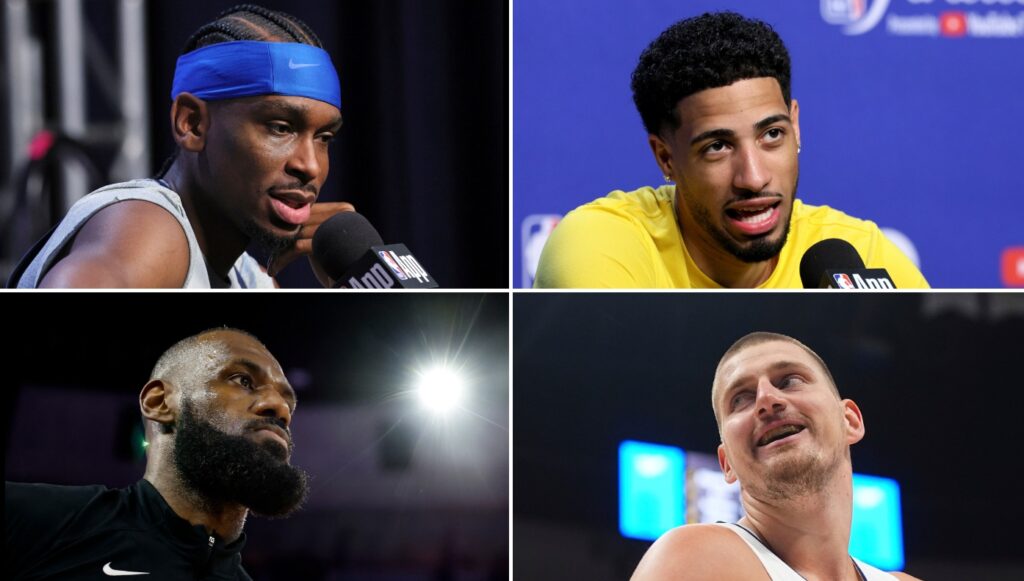Rethinking the NBA’s Iconic Identity in a Changing Landscape
The perennial question of who will emerge as the NBA’s next defining figure remains unanswered, even as the league undergoes a significant transformation. For decades, fans and analysts alike have speculated about the league’s face-yet, in today’s era, the concept of a singular superstar as the sport’s emblem is increasingly obsolete. The recent rise of parity, combined with evolving marketing strategies, has reshaped what it means to be the league’s icon.
The Decline of the Traditional “Face of the League” Concept
Historically, the NBA’s identity was anchored by larger-than-life personalities like Magic Johnson, Larry Bird, and Michael Jordan-players whose rivalries and charisma propelled the league into global prominence. These figures embodied the sport’s cultural zeitgeist, with their stories fueling a narrative of heroism and dominance. However, today’s NBA no longer relies on a single star to carry its brand. The league’s valuation has soared beyond $3 billion for all franchises, with the Boston Celtics’ recent $6.1 billion valuation exemplifying the sport’s broad financial strength. This economic growth diminishes the necessity of a singular face, as the league’s success is now rooted in collective strength rather than individual superstardom.
The Evolving Nature of NBA Stardom
The idea of a definitive league ambassador is complicated by the absence of rivalries that once defined eras. The legendary Bird vs. Magic rivalry, for example, set a template for storytelling that no current player can replicate. Similarly, Michael Jordan’s journey from a rising star to a global icon remains unparalleled, and no current player has yet to match that level of cultural impact. Today’s stars-LeBron James, Stephen Curry, Kevin Durant-are celebrated, but their narratives are more fragmented, and their paths to superstardom are less dramatic and more transient.
The Parity Revolution and Its Impact on Star Power
Recent playoff results underscore this shift. Even the most prominent players-LeBron James with the Los Angeles Lakers, Stephen Curry with Golden State, Kevin Durant with Phoenix-have faced early exits or underwhelming postseason runs. For instance, James was eliminated in the first round despite a talented roster, and Curry’s Warriors couldn’t advance past the second round due to injuries. Young stars like Nikola Jokic, Anthony Edwards, and Jayson Tatum have also experienced playoff setbacks, illustrating that individual dominance no longer guarantees postseason success.
This trend reflects a league where team cohesion, strategic adaptability, and collective effort are increasingly valued over individual brilliance. Myles Turner, a key player for the Indiana Pacers, highlights this shift: “It’s a new blueprint for the league,” he states, emphasizing the importance of teamwork, defense, and camaraderie over star-studded lineups.
The Challenges of Defining a League Icon in Modern Times
The traditional criteria for the NBA’s face-championships, MVP awards, charisma, and marketability-are now less straightforward. In an era saturated with distractions, capturing widespread attention requires more than just on-court success. Players like Shai Gilgeous-Alexander, who recently won MVP at 26, could become the league’s new figurehead if Oklahoma City secures a championship. Yet, he lacks the larger-than-life personality that historically propelled players into superstardom, and financial and league-imposed constraints threaten the rise of any single dominant figure.
The Future of NBA Leadership and Marketability
The league’s recent rule changes aim to curb the dominance of superteams, making it more difficult for any franchise to assemble a roster of multiple superstars through free agency or trades. This shift promotes a more level playing field, where success depends on team chemistry and strategic development rather than star power alone. Consequently, the concept of a “face of the league” becomes more complex, as the spotlight is now shared among many emerging contenders.
The Significance of the MVP and Championship Droughts
Historically, MVP winners often enjoyed postseason success, with 14 of the first 69 MVPs winning championships-roughly one in five. Since 2015, however, the correlation has weakened, with MVPs frequently falling short in the playoffs. Nikola Jokic, a three-time MVP, and Giannis Antetokounmpo, a two-time MVP, have faced criticism despite their individual accolades, highlighting the league’s evolving standards. Joel Embiid, the 2023 MVP, continues to grapple with questions about his durability and playoff performance. This trend underscores a broader shift: in today’s NBA, individual awards are less predictive of postseason triumphs, and the league’s focus has shifted toward team success.
The Uncertain Path Forward
As the league moves away from the era of dynasties and singular icons, the quest for a new “king” becomes more nuanced. The 2025 NBA Finals are expected to reflect this transition, with ratings likely influenced by debates over trades, team strategies, and emerging stars rather than a single marquee matchup. The league’s emphasis on parity and collective achievement may make it more unpredictable but also more inclusive, offering opportunities for a broader array of players and teams to shine.
Conclusion: A New Era of Collective Identity
While the days of a singular “savior” or “king” dominating the NBA’s narrative may be fading, this evolution opens the door to a more diverse and dynamic league. The focus shifts from chasing a singular icon to celebrating a constellation of talented teams and players who exemplify the league’s new ethos. Until a player emerges who can command the attention and admiration of the entire world, the NBA will continue to redefine what it means to be its face-embracing complexity, parity, and the collective spirit that now characterizes the sport.

